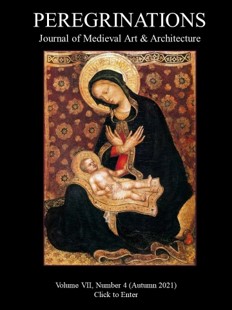Volume 7, Issue 4 (2021)
Welcome to the Autumn issue of Peregrinations which features papers from the 2020 international conference, Spatial Humanities and Urban Experiences during the Long 15th Century, mapping scholars explore how "deep mapping" changes our perceptions and understanding of History. Dan Terkla, who edited these essays, introduces the general theme. This is followed by a forward written by David J. Bodenhamer, who discusses what Deep Mapping is and how it helps us recover lost worlds. Margriet Hoogvliet's introduction discusses spatial humanities and how each of the essays explores and expands that concept. Boris Bove's essay, using these methodologies, puts to rest the notion of exclusive aristocratic quarters in 15th-century Paris. The mapping tells a very different tale. Felicitas Schmieder investigates how Frankfurt in c. 1350 was viewed through the intriguing account of Baldemar of Petterweil, who recorded the urban space within ecclesiastical sources. Margriet Hoogvliet and David Rivaud bring to life the complex neighborhoods of scribes, booksellers, and printers in c. 1500 Tours. The placement of their homes and shops allow a glimpse into a lively trade practice.
Three other feature articles examine a variety of iconographic motifs and how these details created complex meaning. Lars Marius Garshol explores the multi-faceted origin of a woven motif used for protection on everything from sculpture, to architecture, to common tools. Kathryn Blair Moore shines a light on a hitherto often-overlooked detail in 13th-15th-century Italian altarpieces: Kufic writing adorning the Virgin and Child, which add an intellectual and historical layer of meaning. Loretta Vandi's article discusses how a detailed portrayal of a votive gift to the Virgin Mary described by Savonarola acquired a real life of its own through animated devotion.
This issue also includes five thoughtful reviews of books on medieval art and material culture by Sally Badham, Ron Baxter, Stavroula Constantinou, Shirin Fozi, and Michela Young. They introduce volumes on topics ranging from Byzantine intersectionality to reliquary tabernacles to geneological representation and politics, Romanesque tomb effigies, the Dance of Death, and color woodcut prints. This is followed by brief book and new website announcement focused on medieval badges by Ann Marie Rasmussen.
Feature Articles
Mappings Issue Editorial Note
Dan Terkla
Foreword: Deep Mapping of Lost Worlds
David J. Bodenhamer
Introduction: Thoughts about Spatial Humanities and Urban Experiences During the Long Fifteenth Century
Margriet Hoogvliet and Chiara Lastrioli
Mapping Frankfurt c. 1350: Baldemar of Petterweil’s Recording of Space in Medieval Urban-Ecclesiastical Sources
Felicitas Schmieder
Tours around 1500: Deep Mapping Scribes, Booksellers, and Printers
Margriet Hoogvliet and David Rivaud
Olav’s Rose, Perun’s Mark, Taranis’s Wheel
Lars Marius Garshol
Kufesque between Pilgrimage and Polemic: representations of Arabic in Italian Altarpieces, 13th-15th centuries
Kathryn Blair Moore
Book Reviews
Review of Roland Betancourt, Byzantine Intersectionality. Sexuality, Gender & Race in the Middle Ages
Stavroula Constantinou
Review of Shirin Fozi, Romanesque Tomb Effigies: Death and Redemption in Medieval Europe, 1000-1200
Ron Baxter
Review of Beth Williamson, Reliquary Tabernacles in Fourteenth-Century Italy: Image, Relic and Material Culture
Michela Young
Review: Elizabeth Savage, Early Colour Printing: German Renaissance Woodcuts at the British Museum
Suzanne Karr Schmidt
Short Notice
Photo Essay

